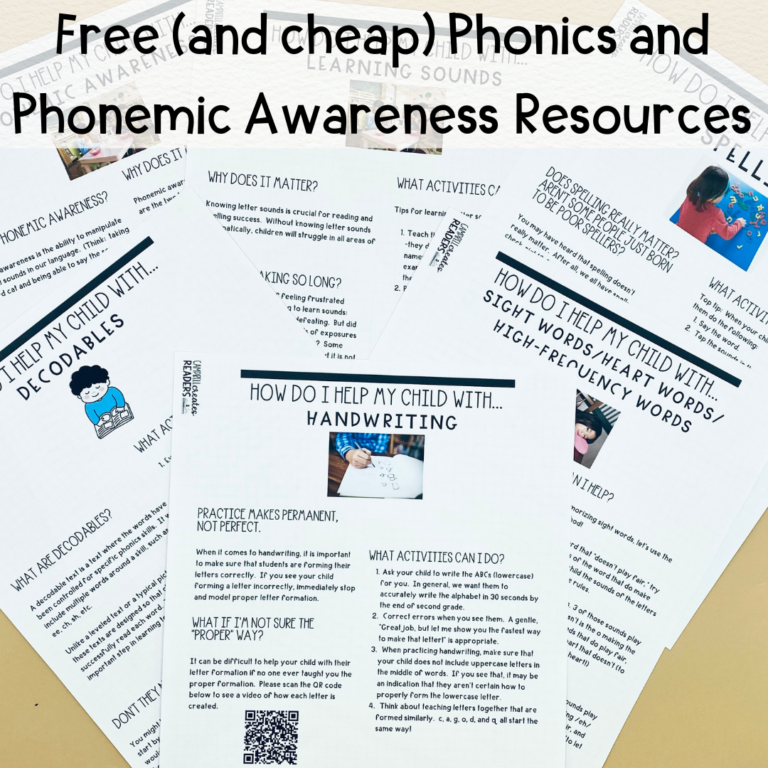
Share This:
Ahhhh, vocabulary. Just the thought of teaching and planning vocabulary used to produce immediate anxiety. You mean to tell me I have to teach phonics, writing, grammar, comprehension, AND vocabulary? Where is it supposed to all happen?
When you don’t see the value in something, it’s difficult to find space for it in your instruction. But once you realize that you literally cannot teach comprehension without teaching vocabulary, another shift occurs. Suddenly you cannot separate the vocabulary instruction from the comprehension instruction, because you know that understanding the vocabulary in a text is directly related to comprehending a text.
Today, I want to share with you my vocabulary planning template. This is the template that I use each time I am introducing a vocabulary word. It gives children the initial introduction of a new vocabulary word, as well as some guided practice towards understanding a word’s meaning.
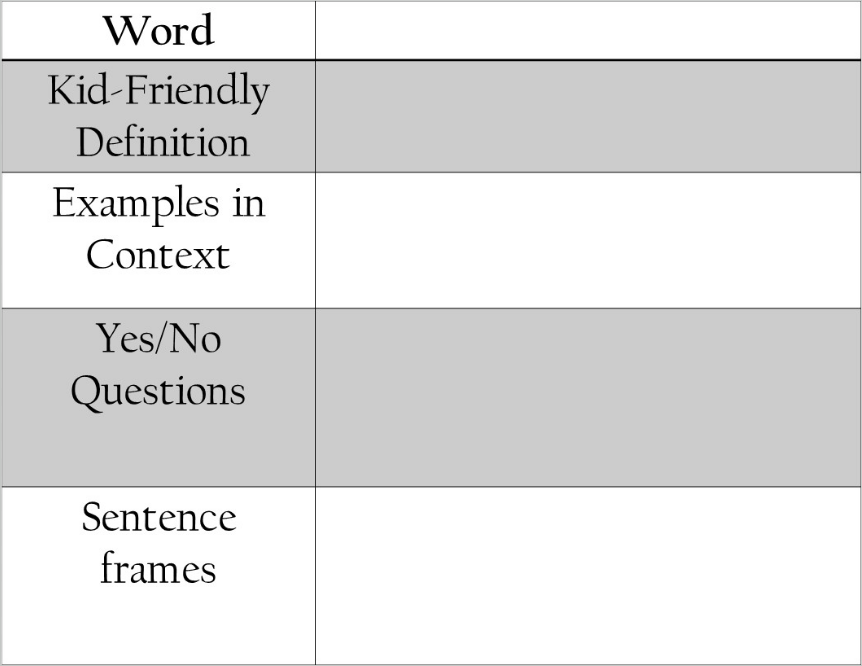
Click here to get a copy of the Google Slides template. You will need to make a copy, but once you do that, the template is yours. Duplicate the slide each time you want to create a new block
This template takes a little bit of time, I won’t hide it. But let’s take a look at what it is and why it’s important, and then I’ll give you a hack that’ll cut down the planning time significantly.
The first thing to ensure with our vocabulary instruction is that our students have a kid-friendly definition for each vocabulary word we are explicitly teaching. Sending a child to look up a definition in the dictionary often leads to more questions than answers. The language in a typical dictionary (and honestly even in the children’s dictionary) is more sophisticated than what our children can handle.

For example dictionary.com gives the following as the definition for scour: “to remove dirt, grease, etc., from or to cleanse or polish by hard rubbing, as with a rough or abrasive material.”
This is a perfectly acceptable definition of scour, for an adult. For a child, however, the awkward phrasing, especially the “from or to cleanse” part, makes accessing the definition nearly impossible. Not to mention the difficulty of words like cleanse and abrasive.
And that definition? It’s only one of 8 definitions for the word.
A kid-friendly definition for the word scour could be as follows: To clean something really well by rubbing it hard, usually with a rough sponge or brush. It can also mean to search carefully for something.
Do you see the difference? The kid-friendly definition is one that students can use to actually access the meaning of the word. If the language of the definition is too confusing for our children, we will never get at a deeper understanding. The point of learning words is not to strengthen our dictionary skills, but to be able to incorporate words into our vocabulary that will help us when we see it in other texts and when we find places to use it in our own conversations and writing.
After the definition, we move into examples in context. Examples give our students an opportunity to see how the word is used in different sentences and with different shades of meaning. If I am taking the word from the text we are going to read (which I almost always am), then I will pull one of the example sentences from the text.
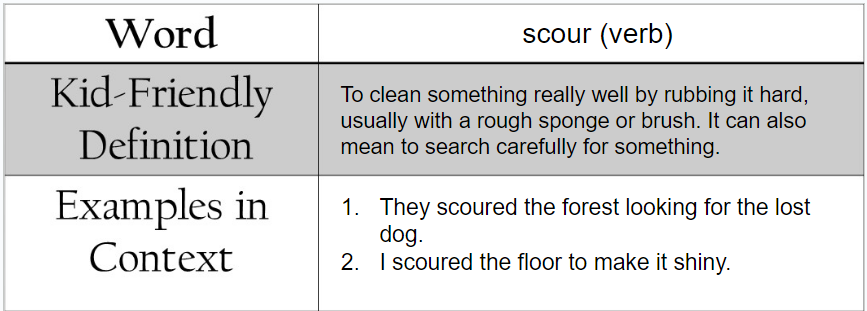
This is an important step because oftentimes we only teach children how a word works in a single context. With the scour example, we might only tell them “I scoured the playground looking for my lost earring.”
So yes, children might understand looking really hard for something they’ve lost, but that doesn’t mean they know how it can work in different contexts. How does scouring a playground look different than scouring a floor? How does scouring a playground look different from scouring a crowd for one’s parents?
I’m not saying we need to share every different definition for the word, especially if this is our first look at it, but we do need to let children see some nuance to the word and how it can work in different scenarios, even for the same definition.
After the kid-friendly definition and some examples, we move into the yes/no question phase. This is an easy, nonthreatening way to allow students to show an initial understanding of the word.
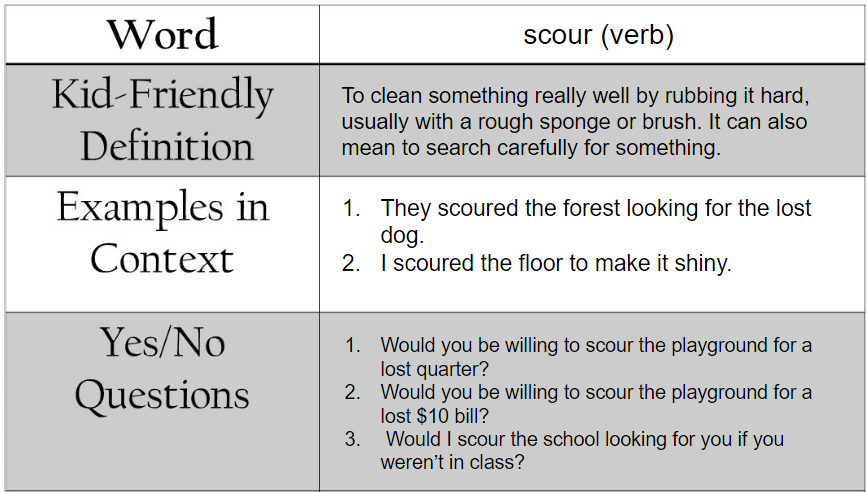
As I ask the questions, students give me a thumbs up or a thumbs down. This is a low-risk way for the teacher to check for understanding. Many of the questions I ask can be answered yes or no depending on a child’s opinion. With those kinds of questions (Like would you scour the playground for a lost $10 bill?) I will ask children to elaborate why they chose a specific answer.
By the time we finish the yes/no questions, the students have seen and heard the word multiple times in multiple contexts.
Last are the sentences frames. Let’s forget about just telling kids to write a sentence with a word. Or assigning those sentences for homework. We know where that leads. “I scoured the floor.” “I scoured the kitchen.” “I scoured the forest.” When we simply ask students to write a sentence using a targeted vocabulary word, we end up with a bunch of sentences that are usually technically correct, but do nothing to demonstrate meaning of the words.

Instead, lets use sentence frames. A sentence frame often includes the targeted word and are organized in such a way that children cannot complete the sentence without demonstrating meaning. Instead of asking a child to write a word using scour, we could give them a frame like “I would scour the playground for a _________________________, but not a ______________________.”
Yes, this can take time to plan and put together. If you are someone who likes to use the same texts each year (or who has a curriculum where the texts are dictated), you can do this kind of deep planning once, and then have it to use year after year.
To cut down on the planning time SIGNIFICANTLY, I suggest using ChatGPT. You can use AI to help you create every single component of this. All you have to do is ask it the questions, then copy and paste the results into the planning template. Instead of taking 10-15 minutes figuring out each work, ChatGPT can help you create it in less than 5 minutes.
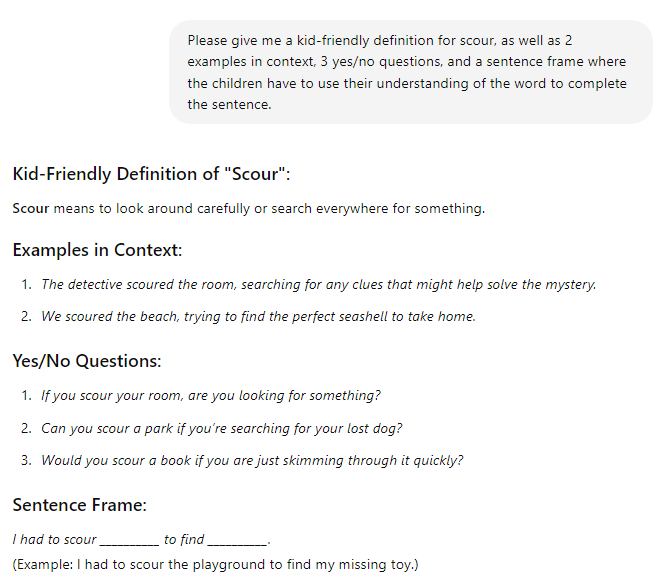
If we aren’t explicitly teaching vocabulary, we are missing out on key ways to improve comprehension with our students. How can we expect students to understand a text on a global level if they can’t even understand it at a word level?
I hope this vocabulary planning template can help make the planning and delivery of explicit vocabulary instruction easier for you!
Share This:

Savannah Campbell is a K-5 reading specialist. She has taught her entire 12-year teaching career at the school she went to as a child. She holds two master’s degrees in education from the College of William and Mary. Savannah is both Orton-Gillingham and LETRS trained. Her greatest hope in life is to allow all children to live the life they want by helping them to become literate individuals.

Savannah Campbell is a K-5 reading specialist. She has taught her entire 12-year teaching career at the school she went to as a child. She holds two master’s degrees in education from the College of William and Mary. Savannah is both Orton-Gillingham and LETRS trained. Her greatest hope in life is to allow all children to live the life they want by helping them to become literate individuals.
Feeling overwhelmed with all the terminology out there? Want to know the key terms all teachers need to teach phonics? In this FREE Rules of English cheat sheet, you get a 5 page pdf that takes you through the most important terms for understanding English—you’ll learn about digraphs, blends, syllable types, syllable divisions, and move. Grab today and take the stress out of your phonics prep!
